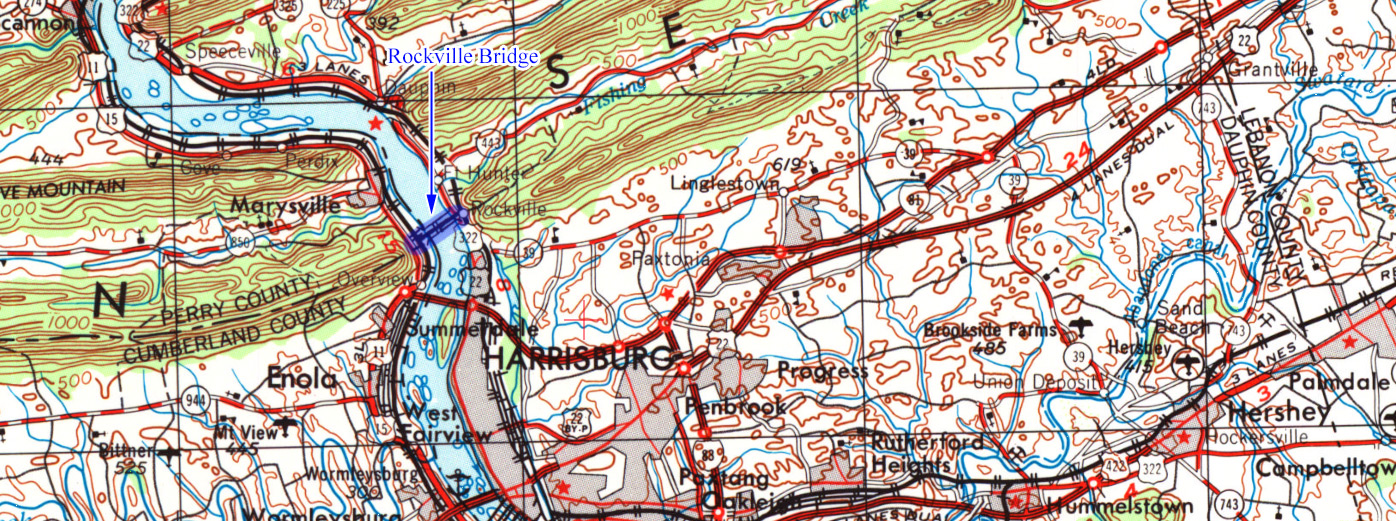PRR's Rockville Bridge, A Stone-Arch Masterpiece
Last revised: August 24, 2024
By: Adam Burns
The Rockville Bridge, located in Harrisburg, Pennsylvania, is the longest stone masonry arch railroad viaduct in the world. Constructed by the Pennsylvania Railroad between 1900 and 1902, it has forty-eight 70-foot spans, for a total length of 3,820 feet.
The bridge, which crosses the Susquehanna River, is still in use today, carrying Norfolk Southern freight trains and Amtrak passenger trains. It was listed on the National Register of Historic Places in 1975.
The original bridge crossed the mighty Susquehanna as early as the late 1840s while the current bridge was not completed until the early 20th century.
Constructed during a time when engineering projects were built to last forever the bridge was so well designed it remains in regular use today under Norfolk Southern.
There is an old expression, "They just don't build things like they used to." That very much holds true for the railroad industry where several early stone viaducts - names like Thomas Viaduct, Starrucca Viaduct, and the Morrisville/Trenton Railroad Bridge all still carry trains - remain in regular service today.
Photos
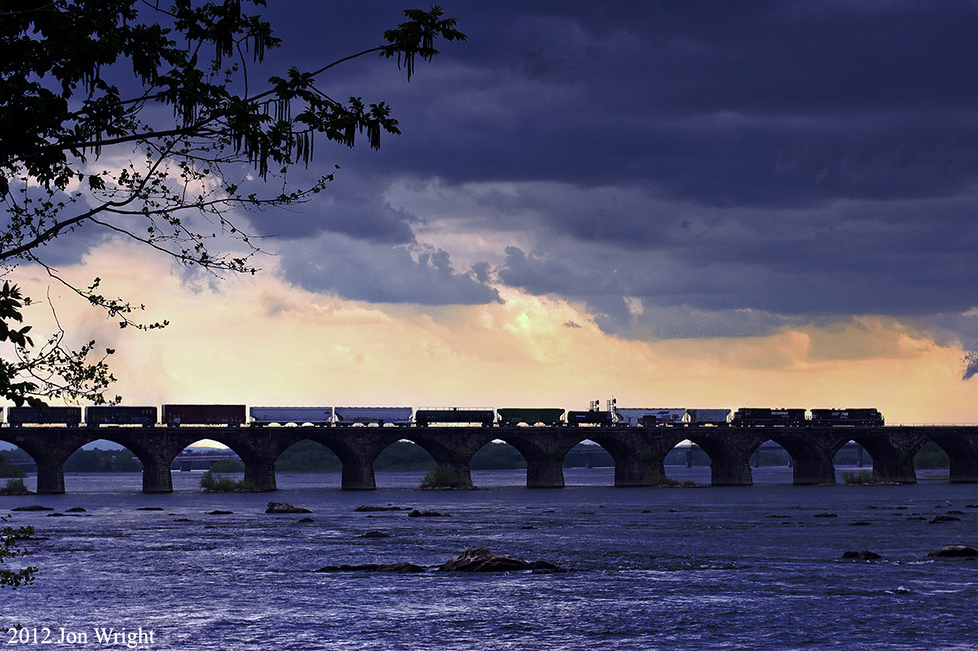 In this dramatic scene taken during a spring thunderstorm, a westbound Norfolk Southern freight crosses Rockville Bridge on April 21, 2012. Jon Wright photo.
In this dramatic scene taken during a spring thunderstorm, a westbound Norfolk Southern freight crosses Rockville Bridge on April 21, 2012. Jon Wright photo.History
Pennsylvania Railroad's Rockville Bridge, located just north of Harrisburg, Pennsylvania, was one of the PRR's many great feats of engineering.
Entire libraries could be written on the Pennsy, ranging from its history to the different businesses it owned. The railroad was an institution to Philadelphia and the state of Pennsylvania.
For over 100 years the keystone represented the PRR as much as it did the state itself. It was born in Harrisburg when the legislature sought a more efficient transportation artery to protect its most important port, Philadelphia.
It also enjoyed strong financial backing as law makers and business leaders sought to ward off competitors, notably the up and coming Baltimore & Ohio. As the railroad became more successful it upgraded its property accordingly, sometimes widening its main line to as many as four tracks.
The PRR also had the most extensive electric operations of any private carrier in the country, most of which is still operated today by Amtrak and regional commuter systems.
In 1915 the Pennsylvania began electrifying portions of its eastern main lines where commuter and passenger operations were the most extensive; by the late 1930s this network had reached as far north as New York, as far south as Washington, D.C., and as far west as Harrisburg.
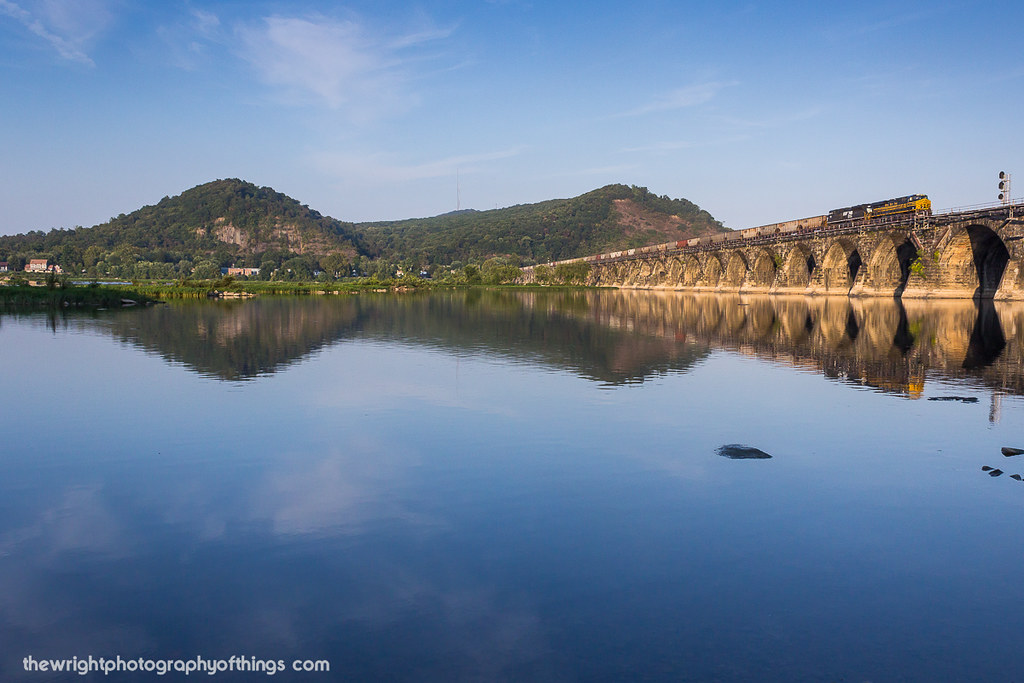 Norfolk Southern's Nickel Plate Road heritage unit leads a westbound freight over Rockville Bridge spanning the Susquehanna River on September 6, 2015. Jon Wright photo.
Norfolk Southern's Nickel Plate Road heritage unit leads a westbound freight over Rockville Bridge spanning the Susquehanna River on September 6, 2015. Jon Wright photo.Early Bridges
The PRR's original bridge constructed over the Susquehanna River was completed in the late summer of 1849; a single-track Howe truss design which provided the railroad with direct access across the very wide river.
Entirely constructed of wood, save for the stone piers, this span survived an 1868 fire. However, by the 1870s it had become outdated as rail traffic continued to increase.
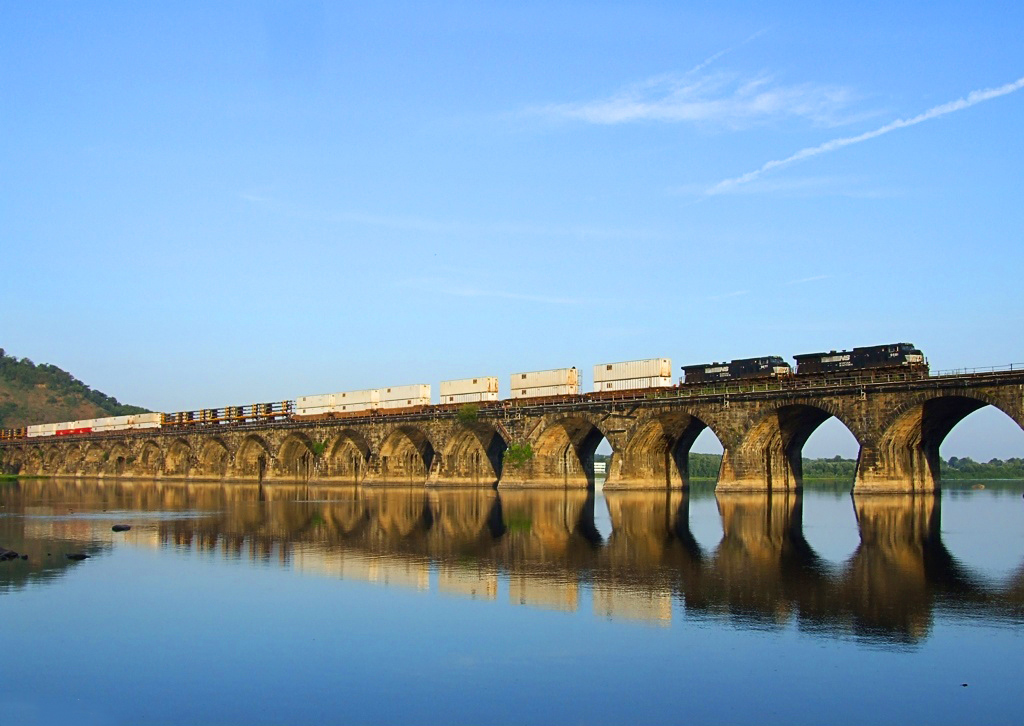 A westbound Norfolk Southern intermodal freight crosses Rockville Bridge on its way to Pittsburgh on August 4, 2007. Rob Kitchen photo.
A westbound Norfolk Southern intermodal freight crosses Rockville Bridge on its way to Pittsburgh on August 4, 2007. Rob Kitchen photo.In 1877 the PRR completed a second bridge over the river that featured two tracks and also used the Howe truss design. This particular span featured iron beams and lattice work.
Once more, however, increasing business resulted in the need for yet another bridge. In an effort to not only alleviate the growing congestion but also provide a permanent solution, the PRR chose a stone arch bridge.
The decision to build such a monumental structure was made under the direction of Alexander J. Cassatt who had been elected PRR's president on June 9, 1899.
Cassatt is best known for completing Pennsylvania Station in Manhattan. However, he also vastly expanded the PRR during his tenure, which ended with his death on December 28, 1906.
Under Cassatt the railroad more than doubled its total assets (from $276 million to $594 million), track and equipment investment increased by 150%, the Northeast Corridor was widened to four tracks, and the main line to Harrisburg/Altoona was double-tracked.
He also signed off on several other stone arch bridges throughout the PRR system to increase rail capacity and move greater freight tonnage.
Construction
The mastermind behind the design of the Rockville Bridge was none other than William H. Brown, the PRR's Chief Engineer.
The stone arch bridge began construction on April 14, 1900. The work was carried out by Drake & Stratton Company and H.S. Kerbaugh, Inc. - both based in Philadelphia - whose Italian workers were master stone masons. It is estimated 300 masons were needed during the project.
The companies skillfully executed Brown’s design, transforming it from parchment to actuality. After two years of relentless toil and meticulous workmanship under the stewardship of Brown, the bridge opened its tracks to the world on March 30, 1902.
Map
The latest bridge was built on a slightly different angle than the previous and was located just downstream.
The mammoth Rockville Bridge stretchedapproximately 3,820 feet across the Susquehanna River. At its highest point, it rises 52.5 feet, making it an imposing yet awe-inspiring spectacle against the Pennsylvania landscape.
The span featured predominantly Hummelstown brownstone, quarried locally in Pennsylvania. Its utilisation contributes not only to the structural strength but also imparts a distinctive charm and a sense of belonging to the local milieu.
The bridge featured 48 stone-arch spans, all of which were exactly 70 feet wide. At the time of its completion the bridge was the longest stone-arch design in the world and still remains as one of the longest ever built.
In all, the Rockville Bridge required 220,000 tons of stone and 150,000 cubic yards of concrete at a total cost of $1,096,000. This investment underscores the vital importance of the bridge to Pennsylvania's transportation network.
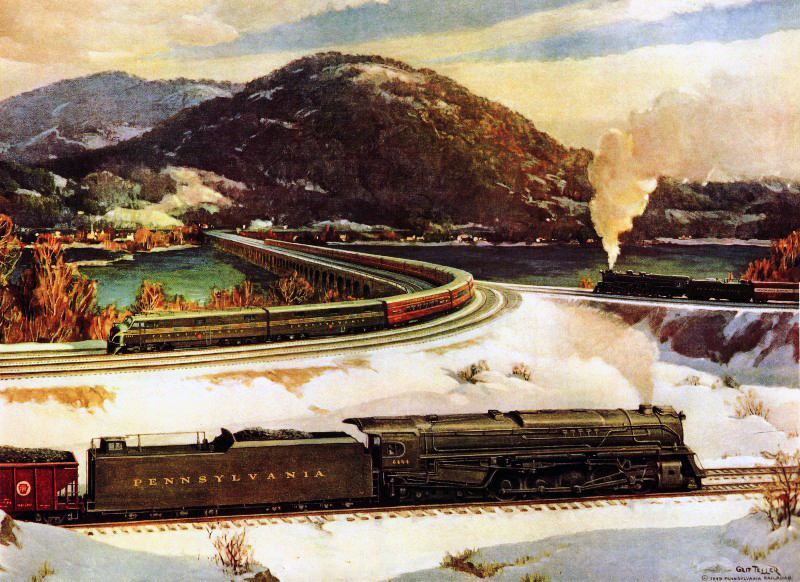 "Crossroads of Commerce." Artwork by Grif Teller, featured in the Pennsylvania Railroad's 1950 annual calendar. This scene depicts the PRR alignment from the Susquehanna River's east bank.
"Crossroads of Commerce." Artwork by Grif Teller, featured in the Pennsylvania Railroad's 1950 annual calendar. This scene depicts the PRR alignment from the Susquehanna River's east bank.Operation
During the PRR era the bridge most commonly featured countless freight trains. However, as Grif Teller's painting above illustrates it also regularly saw most of the Pennsy's famous trains as well such as the Broadway Limited, Jeffersonian, Pittsburgher, and others.
The PRR disappeared into Penn Central of 1968, the disastrous merger with New York Central that resulted in a 1970 bankruptcy. It was subsequently replaced by Conrail's formation in 1976.
The bridge retained its four-track main line until the 1980s when one line was removed. Then, after a container train was blown off the bridge in the late 1990s current owner Norfolk Southern further reduced the tracks to two, centering them in the middle of the structure so as any further severe wind incidents wouldn't result in the train going into the river.
Today, the bridge remains as one of the most impressive bridge engineering feats ever completed and at over 100 years old and still in excellent condition it remains to be seen just how many more years it will remain in operation.
Present Day
The Rockville Bridge is still in full operation today, now under the supervision of the Norfolk Southern Railway. Its continued operation is a testament to the excellent design and construction strategies employed more than a century ago.
Every day, about 60 trains cross the bridge, evidencing its continuous contribution to the modern Pennsylvania railroad landscape. This usage is lower compared to the earlier days, corresponding with the reduced track number from the original four to the current two.
One should not underestimate the importance of the bridge since its inception. Serving as the longest stone masonry arch railroad viaduct in the world, it has been deemed a testament to the human spirit's drive towards progress and innovation.
Despite numerous floods and natural calamities over the years, the Rockville Bridge has endured, thanks to its robust construction and design. It's no wonder that in 1975, it was recognized for its resilience and historical significance, being added to the National Register of Historic Places.
Four years later, its importance was further immortalized by its recognition as a National Historic Landmark in 1979.
Today, the Rockville Bridge stands as not just an operational infrastructure asset, but also a prominent historical monument. Thousands of tourists and locals visit the site each year, appreciating its architectural grandeur and historical significance.
Throughout its lifespan, the bridge has carried countless freight and passenger trains, facilitating economic growth and progress in Pennsylvania and beyond. Even with the advent of new technologies and materials, its relevance remains intact.
The bridge, beyond its operational role, contributes significantly to academic research. Scholars, historians, and enthusiasts around the world continue to study its design, construction techniques, and historical impact, learning invaluable lessons for today's engineering challenges.
Despite its age, it maintains its active role in the railroad industry. Norfolk Southern, which continues to use the bridge today - acquiring it from previous owner Conrail - has invested millions in its upkeep and maintenance, ensuring it will serve generations to come.
Over the years, the bridge has starred in numerous documentaries, feature films, and even postcards. Its unique aesthetic and historical worth make it a darling for photographers and filmmakers alike, capturing its grandeur for posterity.
The bridge's story is intertwined with that of the Pennsylvania Railroad itself. As a representation of the railroad's peak and a relic from its golden age, the bridge conjures up sentiments of nostalgia and pride in residents and visitors alike.
Symbolizing architectural resilience and human perseverance, the Rockville Bridge pays tribute to the pioneers of the railroad era – from hard-working laborers to visionary architects like William H. Brown. It stands as a celebration of human ingenuity and a symbol of triumph over nature's barriers.
The construction techniques used in the bridge, such as the use of stone masonry arches, have largely fallen into disuse in modern bridge construction. However, the bridge serves as a reminder of these historic methods and their sturdiness and durability.
Environmental concerns have been addressed throughout the maintenance of the bridge. Any work carried out on the structure involves extensive planning and ecological consideration, ensuring that the local flora and fauna surrounding the Susquehanna River remain undisturbed.
In conclusion, the Rockville Bridge in Pennsylvania, once constructed to meet the burgeoning needs of the Pennsylvania Railroad and now maintained by Norfolk Southern, is more than a means of transportation. It's a living symbol of human ingenuity, resilience, and progress – a timeless bridge connecting past, present, and future worlds.
Recent Articles
-
The "NW3": Intended For Terminal Assignments
Dec 16, 24 06:10 PM
The NW3 was an early experimental road-switcher design marketed by Electro-Motive to offer a steam-generator equipped light-road switcher for passenger terminal assignments. Ultimately, just 7 were pr… -
The Fred Harvey Company: An Acclaimed Enterprise in Travel and Dining
Dec 16, 24 02:18 PM
The legendary Fred Harvey Houses were a staple service along the Santa Fe's main line for many years and their impact still remains today. -
Kansas City Terminal Railway: Serving Union Station
Dec 15, 24 07:02 PM
The Kansas City Terminal Railway was formed by a consortium in 1906 to handle switching at Union Station. Today, it operates a terminal freight line.
